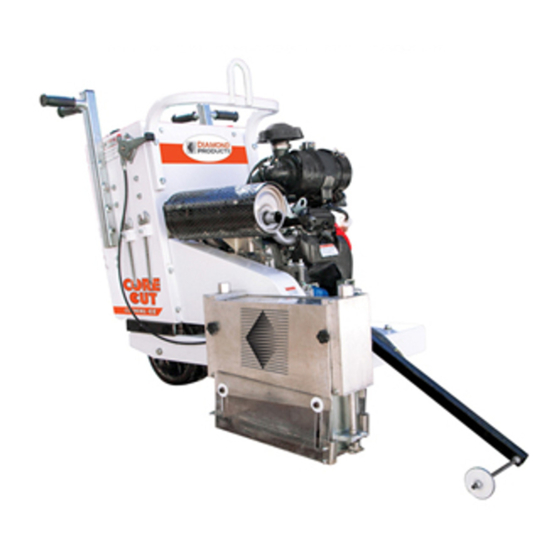Diamond Products CC190PRO 운영자 매뉴얼 - 페이지 8
{카테고리_이름} Diamond Products CC190PRO에 대한 운영자 매뉴얼을 온라인으로 검색하거나 PDF를 다운로드하세요. Diamond Products CC190PRO 16 페이지. Concrete saw

Belt Safety
Turn off the engine and let the belts cool
down prior to servicing them.
Regularly inspect the belts for fraying,
stress cracks, and/or breakage and replace
immediately when damaged.
Always check belt alignment prior to
operating the saw.
Over-tensioning the belts may damage the
power take-off (PTO). Under-tensioning the
belts may cause slippage, shorter belt life,
and/or poor saw performance.
Squealing belts indicate looseness.
DO NOT use old and new belts on the same
sheave together.
Transporting Safety
Remove the blade prior to transporting the
saw.
Close the fuel shutoff valve when
transporting.
Drain the fuel tank when transporting long
distances.
Use heavy-duty ramps that will support the
weight of the saw and yourself when loading
or unloading.
Raise the saw to avoid damaging
components while moving up and down
ramps.
Use extreme caution when
guiding the saw up and down
ramps. Slowly drive/push the
saw forward down the ramp.
Slowly back/pull the saw in reverse up the
ramp. Avoid standing directly downhill from
the saw to avoid serious injuries.
Chock the wheels and secure the saw in a
truck/trailer prior to transporting.
Refer to the Department of Transportation
(DOT) for additional information on proper
transportation techniques and truck/trailer
requirements.
Lifting Safety
Move yourself and all others
away from the lifting area when
8
hoisting the saw to prevent being crushed.
Secure the appropriate hoisting cables,
straps, and/or chains to the saw's
designated lift points prior to hoisting. DO
NOT attempt to lift the saw irresponsibly
and/or improperly
Diamond Blade Safety
WARNING
DO NOT exceed the blade's
maximum recommended speed when
cutting. Excessive blade speeds can
cause blade breakage, resulting in serious injuries
and/or death.
Using the proper blade (size and type) preserves
the blade and improves cutting and operator
efficiency, resulting in lower costs. Refer to
www.diamondproducts.com for a list of different
blade types and additional blade information.
Inspecting the Blade
Inspect each blade prior to installation and discard
all damaged blades. Inspect all blades for:
Cracks, nicks, and dents.
A damaged and/or deformed arbor (center
hole).
Darkness and/or discoloration near edge of
blade.
A deformed blade circumference.
Segment loss and/or segment cracks.
Core wear.
Bending.
Uneven side-widths.
Diamond Blades
